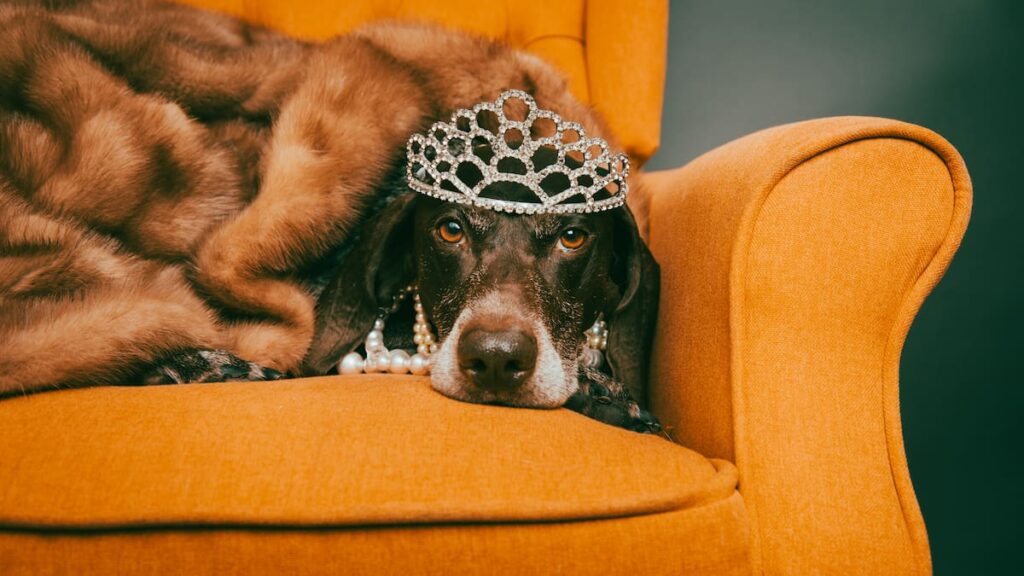“I don’t see anything wrong with wanting the same quality of life for my dog that I’d want for myself or my family,” she says. “It’s very different from when I was young, when dogs were outside pets, but I don’t have kids, so Phoebe is like my child. Dogs have such short lifespans so I want to spoil her and give her the best possible life.”
Cross is in her 50s, divorced and a lawyer (hence her wish for anonymity). Since getting her furry pal, she estimates she’s spent north of $25,000 in the past two years, including surgery to correct Phoebe’s dodgy hips, $825 on a Harris Tweed dog bed, regular training sessions with a dog behaviourist ($150 an hour), monthly grooming and massage appointments (around $100 each), a Hermes dog collar ($1200) and a wardrobe of dog clothes including a Gucci raincoat ($1700), Halloween costumes and Christmas jumpers.
When Phoebe isn’t at doggy day care ($55 a day) or flying with Cross to visit family in Christchurch ($300 return), she’ll be consuming the meals her owner cooks for her.
“I don’t even eat meat, but I’m happy to buy and prepare it for Phoebe.”
Cross is one of the 64% of dog owners who, a UK study estimated, cooked their pets a separate meal at least three times a week. A 2019 Canadian Veterinary Journal poll also found that “most pet owners give equal or greater priority to buying healthy food for their pets compared with themselves”.
Cross admits people who don’t share the same connection with their dog might find it hard to relate to her level of commitment or the money she spends.
“I understand that in a cost-of-living crisis, not everyone has the cash to do what I do. But Phoebe brings such joy to my life and has shown me more unconditional love than any human ever has. If I don’t spoil her, who will?”
Some might suggest Cross is barking mad. After all, Phoebe doesn’t know the difference between a Burberry dog bed and one from the Warehouse, and she couldn’t care less if she was sprayed with a dog perfume ($50 for 90ml) or flea spray.
But the stats tell their own story: more than a third of Kiwi households own at least one dog and we spend an estimated $1.8 billion a year on our pets (up from around $1.6b in 2011), including everything from pet insurance to food, minding services, grooming and pet care luxuries.
Such as dog portraits. Julia Holden is a Waiheke Island-based multidisciplinary artist who has Kiwis lining up for her oil portraits of Fido (as well as cats, rats and rabbits).

Her clients include not just celebrities but families who save the $1500-$2350 to have their pets immortalised on canvas.
Holden started painting pets after “a year of loss in which I wanted to bring some joy into my life”. Owners began reaching out, many of them families.
“It’s not just single, wealthy apartment-dwelling owners who see their pets as family. Lots of different people love their pets and are willing to spend money on them.”

Holden, who donates some of the proceeds from her exhibitions to pet charities such as the SPCA, admits to being more of a cat person but understands why many of us lose our minds over our canine buddies.
“I meet lots of dog owners who would spend their last dollar taking their dog to the vet rather than themselves to the doctor. Some of that dedication is to do with the fact that life can be hard: we’re living in difficult, divisive times and can often feel overwhelmed by what we can’t control. In contrast, our companion animals offer us an uncomplicated relationship, one that can feel more direct, playful and joyful. It’s not surprising that we fall in love with them and want to spoil them rotten.”
Not far from Holden’s studio, Lauren Young is carefully etching the name Ralph into a ceramic dog bowl. Young left a career in PR 10 years ago to become a ceramic artist, handcrafting homewares such as cups and platters. One of her biggest sellers is dog bowls, which retail for around $45, often with the dog’s name etched in the pottery.

“I’ll customise them for dogs so, for example, big sloppy dogs need bowls with tall sides so they don’t slop their water, whereas smaller dogs need wider bowls with shorter sides,” explains Young, whose two dogs never stray far from her Waiheke studio.
“I’ve also designed a bowl for greedy dogs, which slows down how fast they eat, so they don’t get sick.”
Customers, who can choose a colour to align with their home decor, come from across Aotearoa and include famous faces, as well as people who “want to express their love for their dogs”.
“It’s been a tough year financially for many Kiwis but we still want to treat our family members, including our patient, wonderful dogs who ask so little from us but give us so much in return.”

Michelle Matravers likens it to the lipstick index – the economic theory positing that in a recession, consumers might, for example, be unable to buy $400 shoes but can stump up for a $40 lipstick.
It’s the same with pet products, says Matravers, who founded Christchurch’s boutique dog lifestyle store Charli & Coco in 2020.
“People are still spending on their dogs, including $700 eco-friendly European dog beds and $200 German leather collars, but they’re making more conscious decisions to buy better-quality products which last longer than cheaper items that might fall apart after a year.”

The mother of two adult children and three dogs admits many of her customers are paying for it by diverting cash from dining out or gym memberships.
“Instead of spending $200 on dinner, a couple might buy a new collar and a few treats for their dog or cancel their gym membership because it costs nothing to walk the dog, and both you and the dog are getting exercise and having important bonding time.”
Matravers’ customers range from empty nesters and cashed-up retirees to younger singles and couples who can’t afford kids but are happy to indulge their dogs.
“There’s also the guilt factor – they don’t have much time to spend with their pet so might compensate by spending a lot on the animal.”
Even in the five years she’s been in business, Matravers has noticed the landscape changing, with greater availability of products such as canine clothing, ice cream, beverages and wellness products.
“We used to be behind the US and Europe on a lot of those trends but are catching up, especially when it comes to wellness for our dogs, with dietary supplements, physio and massage.”
It takes a lot to rile Selina McIntyre, but an over-pampered pooch might do it. The dog behaviourist has spent 21 years working with dogs and their owners so can spot a spoiled woofer at 10 paces.
Often, McIntyre believes, the pampering can be a reflection of an owner’s emotional needs.
“If people are anxious, lonely, lacking affection or feeling vulnerable, they can compensate for those feelings by spoiling their pets,” says McIntyre, who shares her Matamata home with two children and possibly the nation’s best behaved border terriers, Lily and Trev.
Seeing dogs as mini-humans can also lead to unhealthy behaviours for both humans and pets.
“No matter how many cute outfits you dress them in, or how many toys they have, they’re still dogs and by not treating them as dogs, you’re doing them a disservice because that can elevate the dog’s social status beyond their human owners.

“A dog that eats at the table with humans, sleeps on their bed or lies on the back of the couch above their owner’s head will see itself as privileged and like the king or queen of the castle. That gives the dog a huge burden of responsibility to look after everyone in the pack.”
McIntyre, who wrote Big Dog, Small Dog: Make your dog happier by being understood, says when the dog can’t see all those pack members – for example, when the owner goes to work and they don’t know where they’ve gone or when they’ll be back – it can be stressful and cause separation anxiety.

Cue whining, barking, furniture-chewing, sleeping with one ear or eye open – or horrifically, self-harming – because they can’t fully relax.
“I’ve seen dogs who’ve run through plate-glass windows or cut themselves jumping over wire fences because they’re desperate to get to their owners. Those constant cortisol levels aren’t good for the dog.”
The key, says McIntyre, is to redraw the household’s hierarchy so you’re the king/queen of the manor and the dog is, well, a dog. And ensure that a dog’s basic needs for physical and mental stimulation are being met.
“Some dogs have boxes of toys and haircuts that cost more than mine but they’re not getting the physical and mental stimulation they need. So make sure your dog has exercise and training, because that goes a long way to ensuring good behaviours.”
*Name has been changed to protect identity
Sign up to The Daily H, a free newsletter curated by our editors and delivered straight to your inbox every weekday.


